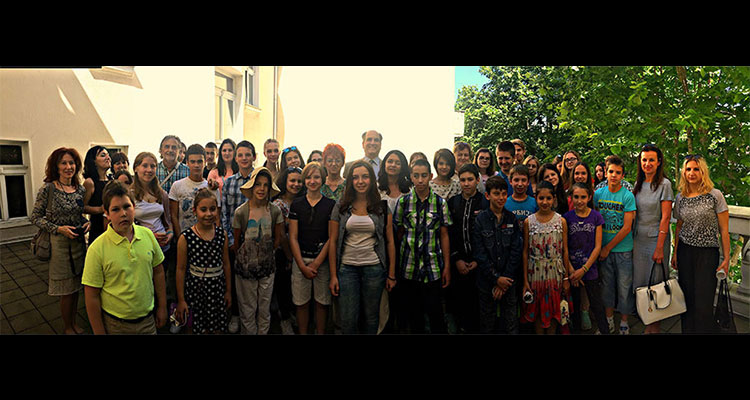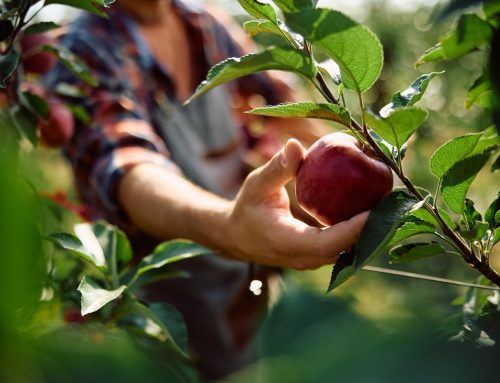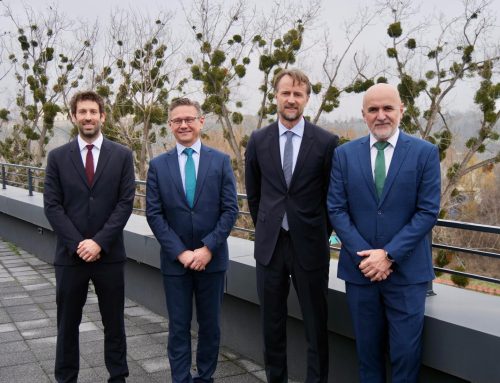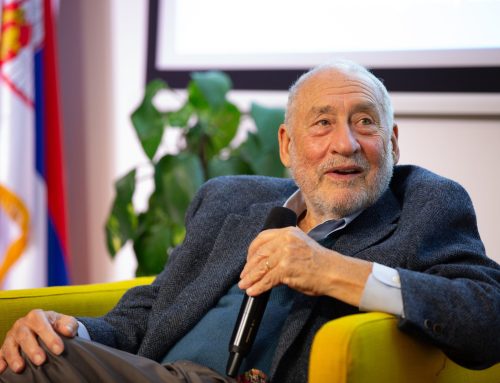Over 40 pupils from several primary schools in Zrenjanin have visited Greek Embassy within the “Open Doors” campaign traditionally organised by EU Member States with support from EU Delegation to Serbia and EU Info Centre.
The children who have paid a visit to the Embassy took part in the quiz about the EU and presented Greece during European Village event which recently took place in Zrenjanin.
They were welcomed by Ambassador Konstantinos Ekonomidis and Secretary in charge of political affairs Panagiotis Giannakoulias. Pupils asked them different questions such as how does one say “my name is” in Greek and how many of Greek islands are inhabited. Their hosts told them how the Embassy worked and that Greece became the tenth member of the EU in 1981. The pupils also learned Greece had centuries-old friendly relations with Serbia and was supportive of its EU path.
Ambassador Ekonomidis said he was happy to see the young pupils showing interest in Greek culture and the European Union, whereas Secretary Giannakoulias said “Greek has had its Embassy in Serbia for more than 130 years, but the friendship of our two nations lasts much longer which makes it much easier for Greek diplomats to do their job in Serbia, and vice versa.”
Ambassador Ekonomidis thanked pupils and teachers for their visit to the Greek Embassy by giving them books for their school library and wishing them good luck and success in their further education.
“Now we know what the Embassy is and how many Greek islands there are”
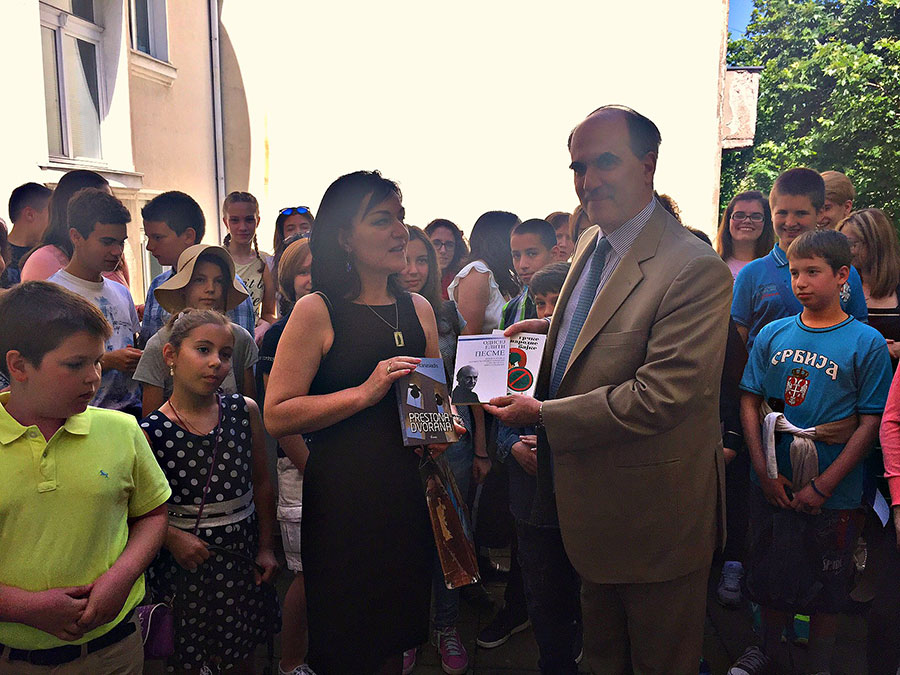 Pupils and their teachers’ trip to Belgrade was organised by the EU Info Point Novi Sad. Zdenka Vukovic, teacher at “Dr Jovan Cvijic” primary from Zrenjanin, told us they were paying a “return visit.” On the occasion of Europe Day, the school she works at holds the European Village event where pupils present European countries in a unique way. This year, they “hosted” Greece.
Pupils and their teachers’ trip to Belgrade was organised by the EU Info Point Novi Sad. Zdenka Vukovic, teacher at “Dr Jovan Cvijic” primary from Zrenjanin, told us they were paying a “return visit.” On the occasion of Europe Day, the school she works at holds the European Village event where pupils present European countries in a unique way. This year, they “hosted” Greece.
“We have prepared a special programme, showcasing pupils’ works and different products related to Greece. My class and I welcomed Second Secretary of the Embassy who toured our school so today we brought a CD with the video of that visit with us. With us here today are the pupils who come from several schools, from second to eight grade, some of whom have won awards in competitions,” said Zdenka Vukovic.
The children left the Embassy with many impressions. “Paying a visit to the Embassy and being friends with many foreign countries, including Greece, means a great deal to me. I have never been there but I do know that Greeks and Serbians share the same religion,” said sixth grader Ivan Zekic. His friend Olga Dragas said they “learn all sorts of things in history classes” which is why she knew that “Greece has laid the foundation of the culture as we know it. I learned a lot today: when it entered the EU and how many islands it has.” Olga went on to describe European Village stand of her school. “We decorated the stand with Greek columns and we were selling Greek flag fridge magnets, necklaces and other things, while the music played at the stand next to ours.”
Her slightly older friend chimes in to explain: “I was a rhythm guitarist in the band playing at that stand. We played two Greek compositions, can’t remember their names, and two Serbian pieces: “Tamo daleko” and “Krece se ladja francuska.” These are Serbian songs but were composed in Greece.” Another boy joins the conversation to tell us about how they danced syrtaki. Amid this spontaneous hubbub revolving around who knows what about Greece, fifth grader Filip Onc says: “I know it is a country of tourism and a very beautiful one, too.” His older brother Stefan adds: “I did not know what the Embassy is and what it looked like. Now I know more about Greece.”
“Why the EU helps poor countries?”
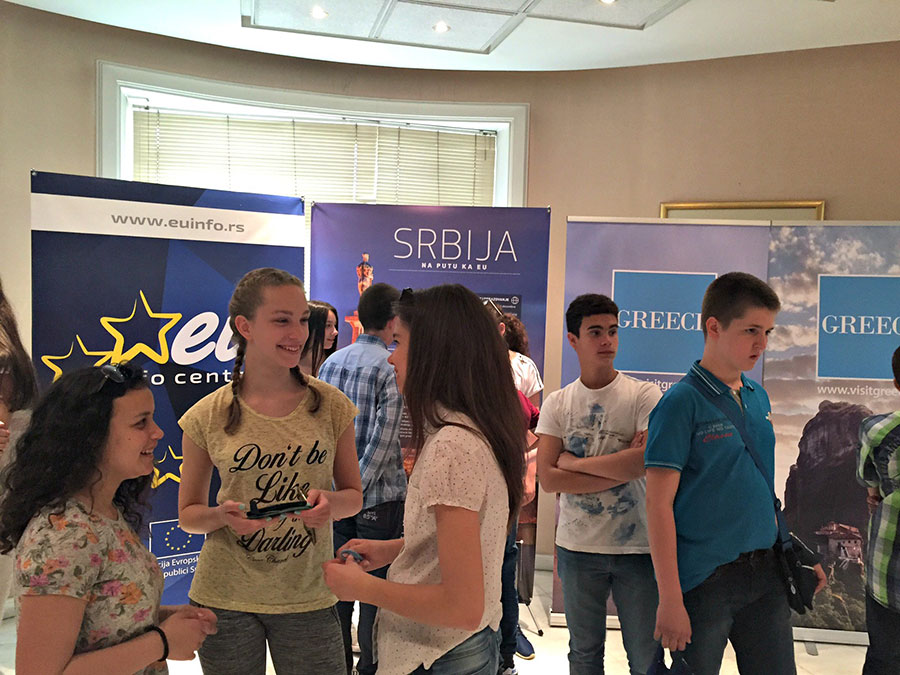 The pupils also visited the EU Info Centre where they watched a film about the creation and development of the EU during its first 50 years and a short video titled “This concerns us” about negotiation and accession process Serbia was going through and criteria it had to meet in order to become an EU Member State.
The pupils also visited the EU Info Centre where they watched a film about the creation and development of the EU during its first 50 years and a short video titled “This concerns us” about negotiation and accession process Serbia was going through and criteria it had to meet in order to become an EU Member State.
Among them were the ten best contestants of the quiz “How well do I know the EU” who, while talking to members of the EU Info Centre team, answered short questions about the history of the EU.
Also, primary school pupils were interested to know what Serbia would look like once it joins the Union; whether the recognition of Kosovo was among the conditions for the accession; and whether the EU perceives Kosovo as part of Serbia or not.
The children also wanted to know which countries apart from Serbia were awaiting EU membership and learned these were the FYROM, Albania, Bosnia and Herzegovina, Montenegro, Ukraine, Georgia and Moldova. They wanted to know why the EU helped poor countries and how many chapters Serbia had closed thus far.
During their visit to the Centre, the children could learn more about the path Serbia had to take before it ratified the treaty on accession and held the referendum in which citizens would decide whether they were in favour of the EU membership or not.
EU Info Centre representatives told pupils from Zrenjanin their job was to bring citizens closer to the possibilities of the EU such as studying, seminars, volunteer camps and travelling.
During their visit to Belgrade, primary school pupils from Zrenjanin also visited Hellenic Foundation for Culture where, among other things, they found out which Serbian words had been derived from Greek language and paid a visit to Nebojsa Tower in Kalemegdan just before heading back home.

